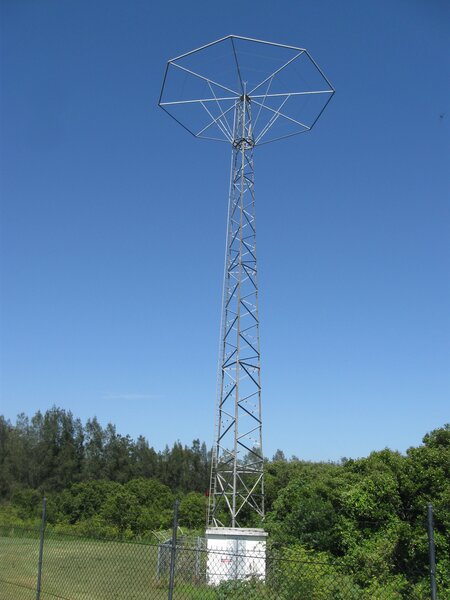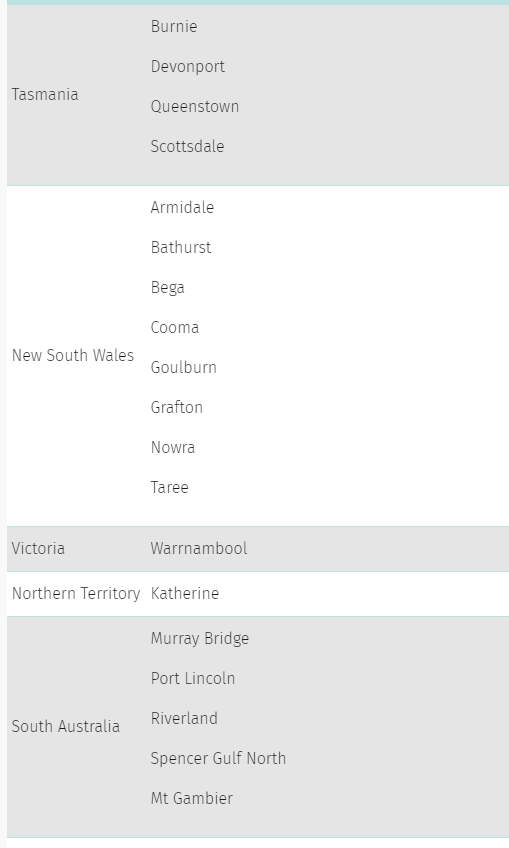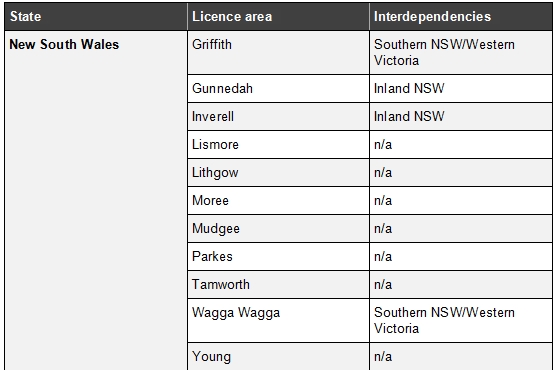

As the populace becomes used to things
being switched off (analog TV, various generations of mobile phone service,
etc.), the question arises, particularly among vintage radio enthusiasts,
"Will AM radio be turned off?". The short answer is eventually, yes. In
fact, the process has already begun in regional areas.
There's several reasons behind this:
Manufacturers like digital modulation formats because it fits in perfectly with planned obsolescence. All it takes is a simple change to the modulation software, under the guise of 'better sound quality' or 'more stations' to disable existing digital receivers, and to force listeners to 'upgrade'. In fact, it's already on the cards for digital TV, with the existing MPEG-2 system, which has operated since 2001, giving way exclusively to MPEG-4. Naturally, MPEG-2 receivers are not reverse compatible. Contrast this to the introduction of colour TV, AM stereo, and FM stereo, where the systems were specifically designed to be reverse compatible with existing receivers.
Also, digital transmission means that the broadcaster has control over who can listen and who can't. Once radio broadcasting is via the internet and cellular system only, it means that broadcasters can instantly know who is listening (and where), which gives a far more accurate and real time picture of the audience. Listening can be prevented unless the listener creates an account; i.e., supplies personal information, or pays to subscribe. Already, this model exists with internet streaming of television stations.
Have you noticed the endless promotion of listening via "the app" when you listen to any mainstream radio stations? In fact, even talk back radio stations have become so mobile phone based, that people now send their comments in via SMS, rather than ringing up and saying their piece!
When you think about, being able to rustle up a simple AM or FM receiver with only one tuned circuit, and one active component, goes against the consumerist ideal of the modern world, where one is expected to depend on big business for everything. When it comes down to it, disposable electronics is much more profitable for big business. And the way to get the populace to dispose of their electronics and buy new, is to switch off (or 'upgrade') the infrastructure that supports it.
Regional AM to FM Conversion.
AM stations in regional areas are being
turned off right now. The ACMA has since 2016, promoted a conversion
of regional stations from AM to FM. I first became aware of this when one
of my nearby regional stations, 2BS in Bathurst, started advertising the
closure of its AM transmitter at the end of 2018. I recorded what I could
of the event, but unfortunately reception conditions at the time were poor.
As of July 2023, these stations have already closed their AM transmitters:

For NSW, we see that 2AD, 2BS, 2EC, 2XL, 2GN, 2GF, 2ST, 2RE, have
already closed down.
The table below shows the NSW stations
which have requested FM conversion as of September 2022. In NSW, this
will end AM transmissions from 2RG, 2MO, 2NZ, 2LM, 2LT, 2VM, 2MG, 2PK,
2TM, 2WG, and 2LF.

As of September 2022, these stations have yet to 'convert'.
March 2024.

As of 18/03/24, 2MG is the latest to switch off AM.
May 2025.

Another in the list of turned off AM transmitters.
Capital City Conversion.
As of September 2022, it is planned to
convert all of Perth's AM transmitters to FM.

Other capital cities are safe for now,
since sufficient FM frequencies are not available. However, don't get your
hopes up, because:-
![]()
In this regard, Sydney AM music station
2CH was converted to DAB only, in 2020, when its AM transmitter was sold
to the sport station SEN. This was a failure, and 2CH was gone for good
in June 2022.

When 2CH switched to DAB only, it shut down after 18 months.
Listener Demographics.
It's an undeniable fact that of the radio
audience, young people don't listen to AM broadcasting. When was the last
time you saw someone under the age of 50 listening to AM? Young people
are not interested in listening to horse racing or the football. Young
people use social media rather than talkback radio to get their point across.
AM radio stations do not play music that young people like (about the only
exception being Brisbane's Switch 1197).
Let's do a quick analysis of what's on
offer in Sydney:
ABC Radio; stations 2FC, 2BL (currently called 'Radio National' and '702 ABC' respectively), and 2PB (currently called 'Newsradio'). Most young people are not interested in arts and science on 2FC. 2BL is talk all day, and nothing really of interest to young people. 2PB is news and parliament.
2GB. Talk only, and advertising is largely
based on health problems, aged care, and funerals. News repeated every
half hour during the daytime.
2UE. The one remaining music station,
playing mostly 60's and 70's music on a limited playlist. Again, advertising
emphasis is on getting old and sick.
2KY. Horse and greyhound racing.
2EA. The old 2UW transmitter. Run by the
Special Broadcasting Service, this is ethnic programming in foreign languages.
SEN. Previously 2CH, which was a music
station of the format 2UE is now. When the AM transmitter was taken over
by sports station, SEN, 2CH music programming was available on DAB only,
until closure 18 months later.
2RPH. Readings from magazines and newspapers
for visually impaired people.
2SM. Years ago a top rating music station
which appealed to the youth, this is now a talk station similar to 2GB,
and is relayed to many regional stations.
In rural areas, the programming tends to have some local content in the morning, and then afternoon and night programming might be taken from 2GB or 2SM.
With that choice, is there is anything to appeal to the under 50's masses?
Internet Streaming.
This is what will be the end of radio
broadcasting, in all its forms, AM, FM, and shortwave. Already, a few years
ago the Radio Australia shortwave service was shut down. Apart from high
power Chinese and U.S. religious broadcasters, there isn't really much
left on the SW bands.
On a more local level, internet streaming
is now so mainstream, that both AM and FM listening is in decline (as is
off air TV, but that's another topic).
There's a good reason for that. Radio
stations don't play what listeners want. Conservative formats, limited
and repetitive playlists, excess advertising, constant babble, and news
every hour to interrupt the programming, are all turn offs.
Compare that to a playlist of music with
every track being one that you like, with no babble, and if there are ads,
they are short and non intrusive. The choice between the two is obvious.
What about news? Young people get that
by scrolling through social media on their mobile phone. They don't want
to listen to someone reading the same thing out every hour.
Real Estate.
AM transmitters need lots of real estate.
While the tower itself doesn't take up much ground area, the guy wires
do, along with the earthing system. Also sufficient area has to be provided
in case the tower collapses. In an increasingly densely populated city
like Sydney, this is a problem.
In Sydney, the commercial AM transmitters
are located in an area of otherwise high density living, at Homebush. As
Sydney becomes overtaken by blocks of flats, the AM transmitters are now
in the way. Developers want them gone. And as any Sydney resident can tell
you, developers always get their way. One temporary solution has been to
share two transmitters with one tower. Unfortunately, this is a compromise,
since the tower performs better with one wavelength than another.
At its minimum, the only real estate an FM transmitter needs is the roof of an existing building.
Power Consumption.
AM transmitters are inefficient. Half
the transmitter power comes from the modulator, which creates the sidebands.
The carrier itself doesn't convey any program material. Now that electric
power has become very expensive, and its cost will only increase until
the end of civilisation, this has become a significant concern for those
operating AM transmitters. For a metropolitan or town service area, an
FM transmitter requires less power.
Electrical Interference.
Beloved of the manufacturers of anything
electronic in the last 30 years or so, is the switchmode power supply.
Iron cored transformers and linear regulators have succumbed to political
correctness. They are not, to use the buzz words, as "energy efficient"
as switchmode types.
Instead, the reliable and electrically
clean power supply is replaced by something a lot smaller, lighter, and
cheaper, but which not only distorts the mains waveform, also radiates
a lot of RF interference. Unfortunately, this interference happens to be
concentrated at around 50 to 100kHz. Not surprisingly, the harmonics are
very strong in the AM broadcast band.
It's not just switchmode power supplies,
but also radiation from microprocessors switching at ever higher speeds.
Since the advent of high speed internet,
another source of interference for the AM broadcast band has been created,
first by ADSL cabling, and then to a worse extent by the NBN which replaced
that.
With incandescent lamps also now politically
incorrect, the CFL and LED replacement lamps used in their place also have
oscillating or switchmode power supplies. It can be imagined in the evening
with a house full of lights on, how much RFI gets radiated. This is along
with the plethora of IT and audio visual equipment, all with switchmode
power supplies.
The result is AM signals can be made unlistenable
unless you're in a strong signal area. The non-technical listener knows
nothing of noise reducing aerials.
Poor Quality Receivers.
In the days pre-interference, and when
more music was played on AM, the most common reason to switch to FM was
because 'AM is shit quality compared to FM'. As the typical non-technical
listener sees it, there's a lot of truth in that statement. In reality,
it doesn't have to be that way.
The problem is that most commercially
made receivers, especially from the solid state era, have a very narrow
bandwidth. On top of that, particularly with a lot of battery operated
sets, are under-biassed class B output stages, and small speakers. And
then there's the mono signal.

AM was forever tarnished by sets like this.
Narrow bandwidth comes about because most
commercially made receivers, since the early 1930's, are superhets. A superhet
is by nature more selective than a TRF type of set. In the early days,
'knife edge selectivity' was a selling point, because in city areas TRF
receivers, especially of questionable design, could have difficulty separating
all the stations.
In Australia, the geographical isolation
of the stations allows the full audio bandwidth to be transmitted. Unfortunately,
this is lost with most superhet receivers. The reason is that the selectivity
curve of the IF amplifier is determined by cost. With ordinary design techniques,
creating an IF strip which allows, say, 10kHz bandwidth would have poor
overall selectivity, because the response curve has a widening frequency
response as the gain drops off. Typically, a valve superhet might have
a bandwidth of 5kHz at the 3db points.
When transistors came along, the situation
was worsened. Per stage, transistors have lower gain than valves. Transistors
were expensive too, so costs dictated using no more than necessary. The
frequency converter saw the return of the 'autodyne' self-oscillating circuit,
so as to eliminate one transistor. To compensate for lower gain in the
IF amplifier, the IF transformers were designed for higher gain, which
of course means a reduction in bandwidth.
A bandwidth of 2-3kHz is not uncommon.
Unfortunately, the design of transistor IF amplifiers for AM receivers
has remained the same until the present day. The detection stage is usually
a diode operating under less than ideal operating conditions, which adds
to distortion.
These transistor sets were seen as acceptable
in view of the convenience of small size, and long battery life.
Even with supposed "Hi-Fi" tuners, the
AM section was always second class, using the same front end as a pocket
radio.
A few enthusiasts, aware of the good quality signals being transmitted, have used TRF receivers or wideband superhets, with low distortion detectors. Unfortunately, this is not typical of most listeners.
Along with transistors was a return to the class B output stage, something used in some battery operated valve radios for reasons of battery economy. They're more efficient than a class A output stage, so the battery lasts longer for a given power output. However, distortion is higher. In the case of transistor sets, the output stage is often under biassed, to reduce battery current at the expense of crossover distortion. It is true that there are some transistor sets with class A output stages, but mostly these are car sets, or mains operated.
Then there's hopelessly inadequate loudspeakers. After all, one of the selling points for transistors was miniaturisation. Pocket size receivers naturally had pocket size speakers. And there's no way that can be good for low frequency response. Furthermore, the designers knew there was no low frequency response, so restricted the bandwidth of the audio stage too. Bass response of the audio is often reduced for two reasons. It means the output stage is not wasting power for something that wasn't going to be heard anyway on a small loudspeaker. Also, the sound appears 'brighter' by emphasising what little high frequency response remains.
Along with miniaturisation and portability, the ferrite loopstick aerial became a feature of most receivers. Directional in nature, it means the receiver is not always orientated for maximum signal pickup. Worse still, the receiver might be orientated for maximum noise pickup! Then of course, the shorter the ferrite rod is, in the name of cost and/or available space, the lesser is the signal pickup anyway.

Because AM radios can be made with these cost cutting 'features',
they were - and people bought them!
Most transistor sets followed the same format, narrow bandwidth with distortion. It's cheaper to make them this way too, of course. And so we had a generation who only knew this kind of AM sound. When they hear a valve radio with its larger speaker, class A output stage, and wider bandwidth, it's not uncommon to hear the 'valve radios sound so much better' comment.
AM stereo was an attempt in the mid 1980's
at clawing back some of the audience from the stereo FM stations. It fizzled
out pretty quickly. Receivers were few and far between, and listeners just
weren't interested. Rather unusual were talk stations converting to stereo,
which seemed pointless.
It's all rather unfortunate, because AM
stereo through a wideband receiver, was in my opinion, as good as FM. In
fact, the channel separation was noticeably better. By the 2000's most
stations had reverted back to mono. By then, most music stations had left
the AM band in city areas for FM anyway.
It is quite possible to make a wide bandwidth AM receiver, with adequate selectivity, and a low distortion detector. I describe a TRF set with low distortion detector here. But, as always, the buying public wants the cheapest. The fact is that AM does allow some really cheap and nasty designs to be built, while still being acceptable for most listeners. Most listeners have no idea just how good AM can be, having never heard it through a quality receiver. The poor image is stuck with AM forever.
Receivers without AM.
Can anyone name a mobile phone that includes
an AM radio? How about a DAB tuner? What about an old fashioned PC tuner
card?
And don't forget, as of 2023, AM radios
are starting to be dropped from cars. One excuse is that electric cars
use a switchmode controller, and with copious amounts of RF pollution emitted,
are a difficult environment for AM reception. But the fact that a few electric
cars do offer AM reception would indicate the problem is
less than it's made out to be. Aside from that, car marketing is aimed
at young people - and they don't listen to AM anyway. You'll note that
in car entertainment these days is all internet or Bluetooth based, with
a radio tacked on as an inconvenient afterthought.
No Duplication of Services.
Unlike in the U.S., Australian radio stations
have never been permitted to operate both on AM and FM in the same area.
If an AM station wants to transmit on FM, it must give up its AM licence.
Examples of this in Sydney during the 1990's were 2UW which became MIX,
and gave its AM frequency of 1107kHz to 2EA. Similarly, when 2WS transferred
to FM (under the same call sign), its former frequency of 1224kHz was given
to 2RPH.
There's no technical reason of course
for this policy. It's all political because radio stations feel threatened
if their competitors have more outlets than they do. As a side issue, this
has a lot to do with why it took so long to get FM operating in Australia,
which in itself is a rather sad story. Those in charge of the media have
considerable political power.
In the ideal world, AM stations would
be able to transmit on FM as well, so that listeners with either
type of receiver could listen. Thanks to Australian conservatism, it isn't
going to happen.
It's not just AM Radio.
Another document from the ACMA shows the
decline in off air listening / viewing across all the off air media.
Television.
As a slight digression to the topic, the
first television transmitter to shut down as of July 2024 was Channel 10
in Mildura. Viewers were advised to continue viewing via the internet.
Off air television has the same viewer demographics as listeners for AM
radio, so this should come as no surprise. Foxtel shut down its cable TV
service in 2023, with again, the service transferred to the internet.
The transferral of all media to the internet
is happening right now. In short, the younger generation do not connect
with anything unless it comes from the internet. Enjoy the off air broadcasts
while they last!
In Britain.
The BBC has announced the cessation of
all off air transmissions (radio and television) by 2035,
to be replaced by internet streaming.